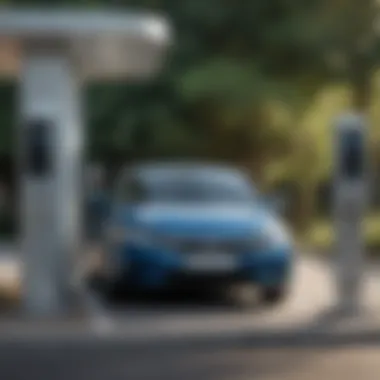Honda Clarity Used Market: Insights and Analysis


Intro
The Honda Clarity has carved a niche for itself in the automotive landscape, standing out with its distinct characteristics and eco-friendly intentions. As the used market for this vehicle continues to grow, prospective buyers must navigate a plethora of considerations to make informed decisions. This exploration dives into key performance metrics, the intricacies of value retention, and the pivotal aspects shaping the Honda Clarity’s standing in the second-hand vehicle space. Armed with detailed insights, shoppers can position themselves to not only assess the car’s features but also evaluate its place against competing options.
Performance Metrics
The performance aspect of any vehicle is often the crux of buying decisions. With the Honda Clarity, potential buyers are not just searching for a ride; they want to know how efficient and reliable it is over long distances, city commutes, and various driving conditions.
Fuel Efficiency
The Honda Clarity shines impressively in the fuel efficiency category. While it’s predominantly a plug-in hybrid, which means it blends both electric and gasoline power, it often leaves others in the dust. In electric-only mode, many users report achieving around 48 miles on a full charge before switching to gas. When driving in hybrid mode, the average breaks down to around 110 MPGe, a noticeable improvement over many conventional vehicles. This makes it not only cost-effective in terms of fuel but also advantageous for those interested in lower carbon emissions.
As individual driving habits vary widely, it's essential for potential buyers to consider their own commuting patterns. Those who primarily travel short distances may find that the Clarity can cover their daily needs on electricity alone, effectively minimizing trips to the gas station.
Handling and Stability
In terms of handling, the Honda Clarity offers a balanced experience that pairs well with daily driving demands. The suspension system is designed for comfort, which allows for a smooth ride over uneven surfaces. However, it doesn't skimp on responsiveness, making it suitable for urban environments where quick maneuverability is crucial.
Drivers often note that the steering feels precise, promoting confidence during each turn. It provides a sense of stability that is especially important in challenging weather conditions or on winding roads. Below, you can find additional factors influencing driving dynamics:
- Tire Quality: The choice of tires can drastically affect handling and should be considered when seeking a used model.
- Weight Distribution: The hybrid's battery placement contributes to a lower center of gravity, improving how it feels on the road.
Car vs Boat Considerations
When pondering the Honda Clarity, potential buyers often encounter comparisons with competitors in the automotive space. Understanding the vehicle's value retention and the manufacturer's reputation can aid in making an informed decision.
Value Retention and Depreciation
Like many hybrid vehicles, the Honda Clarity experiences a notable degree of depreciation, yet it tends to retain value better than some of its peers. One key factor driving this is the manufacturer's commitment to reliability and longevity. Buyers can expect a used Clarity to hold its ground against competition when properly maintained. A typical depreciation rate for this model hovers around 45% from the original MSRP after five years, which is relatively favorable when juxtaposed against gas-only vehicles in comparable segments.
Manufacturer Reputation Analysis
Honda has long been viewed as a reputable make, known for durability and efficiency. The Honda Clarity carries this legacy forward, resonating with eco-conscious consumers who prioritize a company’s environmental initiatives. Reviews often cite Honda’s user-friendly technology and extensive warranty offerings as persuasive factors in their purchase decisions. Popular forums such as Reddit and Facebook groups are rife with discussions emphasizing consumer satisfaction among Clarity owners.
“A lot of my friends have gone for the Honda Clarity because of its tech features and reliability. They rave about how easy it is to drive and how little they spend on gas.” – A satisfied Honda Clarity owner
Ultimately, knowing what to focus on when selecting a used Honda Clarity can reduce the feeling of being overwhelmed in a competitive market. With insights on performance metrics, value retention, and brand reputation, consumers are better equipped to make a decision that aligns with their needs and preferences.
Intro to the Honda Clarity
The Honda Clarity stands as a testament to the shifting gears in the automotive industry, particularly in the realm of hybrid and electric vehicles. Understanding this model is crucial, not just for prospective buyers, but also for those intrigued by the evolving landscape of eco-friendly transportation. The Honda Clarity is not just another car on the market; it embodies innovation and a commitment to reducing carbon footprints while offering a practical driving experience.
Overview of the Model
The Honda Clarity was first introduced in 2016 as part of Honda's efforts to cater to environmentally conscious consumers. This model comes in three variants: the Hydrogen Fuel Cell, Plug-in Hybrid, and Electric. Its design is sleek and modern, merging aesthetics with functionality—a car that doesn’t just look good but serves a purpose.
In particular, the Plug-in Hybrid model captures a sweet spot for those who want both electric efficiency and the flexibility of a gasoline engine without the constant worry about charging stations. Meanwhile, the Electric version is perfect for those looking to fully embrace the electric vehicle experience. Each variant appeals to a different segment of buyers, but they all share Honda’s aim to promote sustainability.
Key Features
When delving into the Honda Clarity's key features, several aspects stand out:
- Fuel Efficiency: With an EPA rating that competes with top-tier hybrids, the Clarity offers substantial gas mileage for those long road trips.
- Spacious Interior: Beyond being eco-friendly, it does not compromise on comfort. Ample legroom and high-quality materials ensure a pleasant driving experience.
- Advanced Technology: Incorporating technology such as adaptive cruise control and lane-keeping assist makes the Clarity not just smart but also safe.
- Eco-Friendly Materials: It's made with sustainability in mind—using materials like recycled plastics and plant-derived materials for upholstery.
"The Honda Clarity isn’t just about fuel economy or emissions; it is a reflection of a lifestyle choice that emphasizes both functionality and environmental responsibility."
Overall, understanding the Honda Clarity’s distinctive features and design philosophy is key to appreciating its place in the used vehicle market. As potential buyers navigate their options, recognizing the specific advantages of the Clarity can empower them to make informed decisions.
In the following sections, we will explore broader market dynamics and pricing trends, showcasing why the Honda Clarity remains a compelling option for both first-time buyers and seasoned automotive enthusiasts.
Understanding the Used Vehicle Market
Delving into the Honda Clarity used market necessitates a thorough grasp of the overarching used vehicle market itself. An understanding on this front can shed light on the buying dynamics, specifically tailored to eco-friendly vehicles like the Clarity.
Market Dynamics
The used vehicle market is a shifting landscape, influenced by various factors such as economic conditions, consumer demand, and regulatory changes. In recent years, the surge in interest for hybrid and electric vehicles has changed the rules of the game. Consumers increasingly turn to automobiles that minimize their carbon footprint while maintaining a degree of performance.
For instance, the price elasticity of demand for used Honda Clarity models has a direct relationship with gasoline prices. When fuel prices soar, buyers become more keen on alternative energy vehicles that promise better fuel economy. This natural demand shift creates a marketplace buoyed by consumer awareness about the environmental ramifications of traditional gas-powered vehicles.
Aside from price fluctuations, the availability of models significantly shapes market dynamics. While Honda produced the Clarity for just a handful of years, it has historically kept its day-to-day functionality at the forefront. Limited availability may put upward pressure on prices, a fact buyers must consider when searching for specific models.
Understanding these dynamics can help buyers make educated choices based on the current supply and demand environment.
Pricing Trends


When looking at Honda Clarity prices in the used market, one can easily see both stability and fluctuation influenced by external factors. During the initial years after launch, you might find pricing for Clarity models rather elevated due to their novelty and fuel efficiency credentials.
However, as more competing models emerged from manufacturers like Tesla or Toyota, the pricing might have softened in response to this increased competition. As with many vehicles, depreciation is an inevitable force, and hybrid models like the Clarity tend to hold their value better compared to conventional vehicles. It's not uncommon to see a Honda Clarity retain around 40-50% of its original value after three years.
Here are some specifics of pricing trends that buyers should note:
- Age of the Vehicle: Older models usually go lower in prices but can lose some technological advancements.
- Mileage: Considered a true barometer of wear and tear, higher mileage often translates to a lower price.
- Condition: A well-maintained vehicle will generally demand a premium.
- Market Seasonality: Prices may fluctuate based on seasons, with summer often being a hotspot for vehicle purchasing.
By keeping an eye on these trends, potential buyers can better navigate their negotiation tactics, regardless if they’re shopping from a dealer or a private seller. Integrating this understanding into the buying process could lead to savings while securing a reliable eco-conscious vehicle.
In summary, grasping the intricacies of the used vehicle market is indispensable for any prospective Honda Clarity buyer. Several interrelated elements drive market dynamics and pricing trends, shaping the buying experience significantly.
Performance Metrics of the Honda Clarity
The performance metrics of the Honda Clarity are pivotal in evaluating its overall value in the used market. This section sheds light on several key elements, particularly fuel economy, driving experience, and reliability ratings. Understanding these aspects not only enlightens potential buyers on what to expect but also aids in assessing the long-term viability of the vehicle in real-world conditions. A car that provides efficient performance can often be a substantial financial boon, especially for eco-conscious consumers eager to balance comfort and environmental responsibility.
Fuel Economy
When diving into the world of hybrid and electric vehicles, fuel economy stands out as a major discussion point. The Honda Clarity boasts impressive figures that resonate with budget-conscious buyers. Generally, drivers report an average of around 40 mpg in hybrid mode, while it achieves even greater efficiency in electric-only mode. Depending on driving habits, it can truly stretch your dollar. With rising gas prices, this kind of efficiency is like finding a needle in a haystack for car owners. Additionally, its electric range can reach approximately 47 miles before needing a charge, which can suit many daily commuting needs.
The blend of electric and hybrid capabilities allows for flexibility. Most people relish the savings at the pump and the reduced environmental footprint. For city dwellers or those with short commutes, running in electric mode can mean skipping the gas station altogether.
Driving Experience
The driving experience of the Honda Clarity is where the vehicle shines—not just in terms of performance metrics but also in comfort and handling. Any user familiar with it might compare the experience to gliding through the city. The car offers a refined ride that competes well with other hybrids, while the smooth acceleration adds to its appeal. The regenerative braking system helps in capturing energy usually lost during braking, contributing to an enjoyable coast through urban streets without sacrificing control.
Drivers appreciate that it doesn’t feel bulky, despite its size. Maneuverability is a plus, aided by responsive steering and a well-tuned suspension that absorbs road imperfections like a sponge. One rarely feels fatigued after driving for extended periods, a boon for those long road trips. The interior design, coupled with its quiet operation, creates a serene environment, amplifying the driving experience even further. It’s worth noting, however, that its weight from the hybrid components can be noticeable in sharp turns, although most drivers find this minor in the grand scheme of things.
Reliability Ratings
Turning our attention to reliability ratings, Honda has a well-earned reputation for producing dependable vehicles, and the Clarity is no exception. Various consumer reports suggest that owners generally express high satisfaction levels, emphasizing that issues are infrequent. The vehicle maintains its value over time, which is an important consideration for buyers eyeing the used market.
It's essential to factor in that maintenance costs tend to be lower compared to traditional combustion cars. Parts tend to hold up well, and with less wear and tear on the engine, the Honda Clarity can deliver longevity that many buyers desire. Moreover, with regular servicing, it ensures that potential glitches are caught before they escalate into significant problems. Many drivers find it reassuring to hear from peers who've owned the vehicle for several years without major expenses.
"A car that’s built to last can save you a pretty penny in the long haul."
In summary, the performance metrics of the Honda Clarity present both compelling advantages and practical considerations. From fuel efficiency that lightens the impact on the wallet to a driving experience that melds comfort with ease, and reliability ratings that reinforce buyer confidence, it’s evident that this vehicle stands tall amongst its competitors. By focusing on these elements, prospective buyers can make informed decisions that align with their lifestyle and values.
Environmental Impact
The Honda Clarity’s environmental impact is a key consideration for buyers, especially in today’s world where eco-consciousness shapes consumer choices. This section will explore the emissions ratings and sustainability factors that underline the importance of this vehicle in reducing one’s carbon footprint and promoting greener practices in the automotive space.
Emissions Ratings
When it comes to emissions ratings, the Honda Clarity is indeed noteworthy. As a plug-in hybrid, it is designed to operate efficiently in both electric and gasoline modes. The EPA has rated the Honda Clarity’s electric-only driving range at around 47 miles, which is quite impressive for a vehicle in its class.
The emissions estimates suggest that, when running on gasoline, the Clarity emits around 104 grams of CO2 per kilometer. This places it among the cleaner vehicles, especially in comparison to traditional gasoline counterparts which often top 150 grams. A vehicle's emissions ratings not only indicate its direct impact on air quality but also reflect the manufacturer's commitment to sustainability.
"In the race toward greener transportation, the Honda Clarity stands tall, demonstrating how innovation can lead to lower emissions without sacrificing performance."
Several factors contribute to the Clarity’s modest emissions footprint:
- Advanced Fuel-Efficiency Technologies: The integration of hybrid technology helps optimize fuel usage.
- Regenerative Braking: This system captures energy that would normally be lost during braking, using it to recharge the battery.
Sustainability Factors
Sustainability in the Honda Clarity isn’t just about emissions; it extends to the materials used in its construction, energy efficiency, and even the lifecycle of the vehicle. Carmakers like Honda are increasingly experimenting with bio-based and recycled materials to reduce their environmental impact. In the Clarity, this includes the utilization of recycled plastics in its interiors, which reflects an effort to minimize waste and promote a circular economy.
In terms of energy efficiency, every Honda Clarity sold contributes to the growth of electric vehicle infrastructure. The more plug-in hybrids on the road, the stronger the demand for charging stations, as well as innovations in battery technologies. This broader adoption can potentially drive down the costs associated with electric vehicles, making them more accessible to the everyday consumer.
Buyers should also consider the importance of charging methods. The use of renewable energy for charging can enhance the vehicle's overall sustainability profile. For instance, utilizing solar panels to power your home can significantly reduce the effective emissions from charging your Honda Clarity,
In summary, the Honda Clarity embodies the principles of a vehicle that is not just a transport mode but a step toward sustainable living. Its commitment to lowering emissions and using sustainable materials makes it a worthy consideration for those eager to make a positive environmental impact.
Comparative Analysis with Other Vehicles
In the current landscape of the used vehicle market, a comparative analysis is crucial for those considering a Honda Clarity. Understanding how it stacks up against competitors not only aids potential buyers in making well-informed decisions but also highlights its unique strengths and weaknesses. Different vehicles appeal to different needs and priorities; thus, knowing where the Clarity stands in relation to other models helps in clarifying the value propositions on the table. Here’s a closer look at three significant competitors that consumers often ponder upon when deciding on a hybrid or electric vehicle.
Honda Clarity vs. Toyota Prius
The Toyota Prius has long been synonymous with hybrid vehicles. It’s like the old reliable that many first think of when they hear the word "hybrid." The Honda Clarity, however, presents more than just a worthy alternative. Here are some key points to consider in this direct comparison:
- Fuel Efficiency: The Prius typically offers a slightly better mpg rating, which can be crucial for consumers focused on minimizing fuel costs. However, the Clarity tends to provide a more refined driving experience.
- Interior Space: While the Prius may excel in fuel economy, the Honda Clarity takes the cake when it comes to cabin size and cargo capacity, accommodating those who often transport family or gear.
- Technology Features: Both cars pack a punch with tech offerings, but many users find the Clarity's interface to be more user-friendly and aesthetically pleasing.
"Choosing between the Honda Clarity and Toyota Prius ultimately boils down to personal preferences regarding space and driving experience, as well as fuel efficiency needs."
Honda Clarity vs. Nissan Leaf


Switching gears to the Nissan Leaf, which shines in the electric sector. It's a popular choice among electric vehicle enthusiasts for several reasons. Here’s how the Clarity and Leaf measure up:
- Electric Range: The Leaf certainly stands out in terms of its electric range, boasting figures that facilitate longer trips without the need for immediate recharging. In contrast, the Clarity's plug-in variant provides a combination of electric-only range and gas efficiency.
- Performance: Enthusiasts often mention the Leaf’s agile handling, while the Clarity delivers a smooth, comfortable ride that might appeal to a broader audience.
- Charging Options: The widespread availability of charging stations does favor the Leaf, but the Clarity's convenience of gasoline backup can be a significant advantage for those who don't have easy access to charging.
Honda Clarity vs. Hyundai Ioniq
Lastly, the Hyundai Ioniq is a formidable competitor that comes in various flavors: hybrid, plug-in hybrid, and electric. This versatility makes it challenging to overlook. Below are some aspects worth noting:
- Customization: The Ioniq's multi-variant approach gives buyers more flexibility in choosing a model that fits their lifestyle. However, those focused strictly on plug-in efficiency might prefer the Honda Clarity's dedicated plug-in hybrid design.
- Stylish Appearance: A lot of consumers have warmed up to the Ioniq’s modern aesthetics, yet the Clarity offers a more boldly styled appearance that some may find more attractive.
- Warranty and Reliability: Hyundai has positioned itself well with an extensive warranty program, a benefit that draws many towards the brand. The Clarity, while dependable, does not offer the same level of warranty and protection on older models.
In summary, the comparative analysis of the Honda Clarity against its competitors like the Toyota Prius, Nissan Leaf, and Hyundai Ioniq reveals that while the Clarity has its merits—like spaciousness and comfort—the choice really comes down to individual needs and preferences. Understanding how these vehicles relate to one another empowers buyers to make a decision that is not just about immediate needs but is also an investment in the future.
Consumer Insights
Understanding consumer insights plays a pivotal role when diving into the Honda Clarity used market. It speaks volumes about the vehicle's performance, reliability, and overall market acceptance through the lens of those who have owned or currently drive the vehicle. In today's automotive landscape, where choices abound, these insights offer valuable perspectives that can aid potential buyers. Knowledge gained from the experiences of others can prevent costly mistakes and highlight features or issues that may not be apparent during a casual examination or a test drive. Thus, digging into consumer sentiments can uncover the hidden gems as well as potential pitfalls of purchasing a used Honda Clarity.
Customer Satisfaction Surveys
Customer satisfaction surveys are crucial tools in gauging how happy owners are with their Honda Clarity vehicles. These surveys typically measure various attributes including reliability, comfort, and overall performance. Many drivers appreciate the innovative features of the Clarity, particularly its spacious interiors and intuitive technology interfaces. Fuel economy often comes up positively in discussions, with many owners remarking on the effective use of hybrid technology, which is, of course, central to the Clarity's appeal.
In exploring results from surveys, one can see that many owners are particularly pleased with the cost savings they experience compared to traditional gas vehicles. On the flip side, some surveys reflect that a few users have encountered issues with battery performance in older models, leading to varied satisfaction levels. Overall, these surveys help establish a clearer picture of what the typical consumer might expect when purchasing this vehicle.
"When prospective buyers see the overall satisfaction ratings, it not only builds trust but also encourages them to consider the Honda Clarity as a credible option in the used car market."
Common User Feedback
Common user feedback goes hand-in-hand with satisfaction surveys. It often reflects informal channels like social media discussions, forums, and dedicated automotive blogs. This feedback provides unfiltered access to owner opinions and can illuminate more nuanced issues that formal surveys might miss. Many users rave about the Honda Clarity’s ride quality and how it handles the road. Those who prioritize green technology often share their appreciation for its low emissions and effective hybrid functionality.
However, some drivers have pointed out concerns regarding the availability of service parts and options for customization. Depending on where they live, a handful express challenges in finding service centers knowledgeable about hybrid technology, which can add layers of frustration when seeking repairs. Feedback like this is essential for potential buyers to consider, especially if they foresee long-term ownership of the vehicle.
Ultimately, both customer satisfaction surveys and common user feedback together create a comprehensive picture. This collection of insights provides potential buyers with an informed perspective on the Honda Clarity and strengthens their purchasing decisions.
Buying Considerations for a Used Honda Clarity
When diving into the second-hand car market, specifically for the Honda Clarity, there are vital considerations to keep in mind. This section is about understanding what makes the Honda Clarity unique and what prospective buyers should prioritize to ensure that they make a sound investment. Knowing what to look for can prevent a number of headaches down the road, both figuratively and literally.
The Honda Clarity represents a blend of innovation and sustainability, which can be attractive for environmentally conscious consumers. However, buying used always comes with its own set of challenges and trade-offs. It is critical to weigh elements such as vehicle history, condition, and overall market trends before making a choice. Each of these factors can significantly influence not just the purchase price, but also the enjoyment and reliability of the vehicle post-purchase.
What to Look For
When you're on the hunt for a pre-owned Honda Clarity, there are specific details that will give you better insight into the car's health and value. Here are key aspects to consider:
- Vehicle History Report: Always request a vehicle history report through services like Carfax or AutoCheck. This can alert you to any accidents, title issues, or extensive repairs the vehicle may have undergone.
- Battery Condition: The Clarity comes with a sizable battery that can wear down over time. Test for charge capacity and inquire about any service records. A healthy battery means better range and reliability.
- Service Maintenance Records: A well-documented maintenance history speaks volumes about how the previous owner cared for the vehicle. Look for regular oil changes and other routine services.
- Interior Condition: Pay attention to the dashboard, upholstery, and overall interior layout. Signs of excessive wear may indicate neglect, even if the outside looks appealing.
- Test Drive: Never skip the test drive. This is your chance to catch any odd noises, check the responsiveness of the brakes, steering, and how the car handles on the road.
"A car might shine on the outside, but it’s what’s lurking under the hood that counts."
Inspection Checklist
Once you have a model in mind, it's wise to run a thorough inspection to prevent surprises later. Below is a handy checklist for assessing a used Honda Clarity:
- Exterior:
- Tires:
- Fluids:
- Electronics:
- Under the Hood:
- Look for signs of rust or body repairs.
- Inspect for uneven paint, which could signal past accidents.
- Check tread wear and alignment. Uneven wear may hint at suspension problems.
- Make sure all tires match in brand and wear.
- Check engine oil, transmission fluid, and brake fluid. They should be clean and at proper levels.
- Inspect coolant levels, especially given the Clarity's hybrid nature.
- Test the infotainment system, navigation, and any safety features like lane departure warnings or adaptive cruise control.
- Ensure the climate controls work effectively, as a malfunction can signal electrical issues.
- Look for any leaks, corrosion, or excessive wear on belts and hoses.
- Consider a mechanic's opinion on battery health, especially if the car is a plug-in hybrid.
Taking the time to go through these points may save you from a money pit or a car that doesn’t meet your expectations. After all, knowledge is your best ally when it comes to navigating the used car market.
Availability and Sources
When unraveling the complexities of the used Honda Clarity market, understanding availability and sources is crucial. With diverse purchasing avenues, potential buyers can better tailor their search based on personal preferences and needs. The dynamics of this aspect not just merely shapes the buying experience but also strongly influences the final purchase price and condition of the vehicle. Here, we will take a closer look at two major sources: dealerships and private sellers as well as online marketplaces, emphasizing the pros and cons each provides to buyers.
Dealerships vs. Private Sellers
Deciding between purchasing from a dealership or a private seller is akin to choosing between apples and oranges; both have their enticing attributes, yet they cater to distinct preferences.
Dealerships:
Opting to buy from a dealership offers the advantage of a controlled environment. Dealerships typically provide certified pre-owned Honda Clarity models, which often come with warranties. This aspect can provide peace of mind to buyers, knowing there’s a safety net should any issues arise post-purchase.
However, this convenience often comes at a premium price. Dealerships have overhead costs that private sellers do not and, as a result, listing prices can be higher. Also, the selection may be limited based on location.
Private Sellers:
On the flip side, purchasing from a private seller may yield more competitive pricing options. Buyers may find themselves pleasantly surprised by lower initial costs, as private individuals are often motivated to sell quickly, especially if they're upgrading or moving out of state.


Yet, buying from a private seller carries its own set of risks. The vehicle's history might not be thoroughly documented, potentially leading to unexpected hidden problems. Buyers need to inspect the vehicle and may want to consider a mechanic’s assessment to avoid future headaches.
"In the end, the choice between a dealership and a private seller often hinges on how much risk you're willing to take and whether you place higher importance on warranty and certified conditions versus potential cost savings."
Online Marketplaces
The rise of online marketplaces has reshaped how we buy used cars, including the Honda Clarity. Platforms like Craigslist, AutoTrader, and other similar websites connect buyers with a broader range of sellers beyond their local vicinity.
Benefits:
- Diverse Options: Buyers can access many listings, enabling them to compare prices and models in one place, finding everything from the base model to the more fully loaded versions of the Honda Clarity.
- Convenience: For those with busy schedules, online browsing allows you to shop at your leisure without the time constraints of visiting physical lots.
However, there are potential drawbacks. Not all listings provide transparent information, and the absence of a dealership's accountability can leave buyers vulnerable.
When using online marketplaces, it's prudent to:
- Research Sellers: Check user ratings and reviews where available.
- Verify Vehicle Condition: Request comprehensive details about the vehicle’s history, such as prior accidents and maintenance records.
- Arrange for an Inspection: Prior to making a final decision, it's advisable to have a trusted technician review the vehicle.
Navigating the availability and sources for a used Honda Clarity is instrumental in shaping an informed purchasing decision. By weighing the advantages of dealerships against the financial allure of private sales and the expansive reach provided by online platforms, consumers can better position themselves to uncover the ideal deal.
Cost of Ownership
When considering the Honda Clarity, understanding the Cost of Ownership is paramount for potential buyers. This term encompasses several aspects, from insurance to maintenance, that directly influence the budget of owning a vehicle. In today's market, where every penny counts, a deep dive into these factors helps prospective owners gauge what they'll be signing up for. By breaking down these costs, buyers can make educated decisions tailored to their financial situations, ensuring they are not caught off guard down the road.
Insurance Costs
Insurance is one of those unavoidable costs that can catch people by surprise. For the Honda Clarity, several elements play into the insurance premiums. First off, the vehicle's classification as a hybrid often leads to slightly higher rates compared to conventional cars. However, many insurance companies offer discounts for eco-friendly vehicles, which can offset this cost.
Moreover, the Clarity’s safety ratings are generally high, which can also lead to lower premiums. It’s wise to shop around and get multiple quotes; different insurers weigh these factors differently. Here’s a brief outline of what to consider about insurance:
- Type of Coverage: Consider whether you’ll go for full coverage or the minimum required.
- Driving Record: A clean record can lead to significant discounts.
- Location: Urban drivers might encounter higher rates due to increased theft and accidents.
- Credit Score: In some states, a higher credit score can land you a better rate.
In summary, while insurance may seem like a straightforward cost, the variables at play mean it’s worth putting in the time to evaluate your options.
Maintenance Expenses
Now let’s talk about maintenance. This is where things can get tricky, especially for hybrids like the Honda Clarity. Generally speaking, hybrids tend to have lower maintenance costs over their lifespan compared to gas-powered cars, thanks to fewer moving parts in the hybrid system. However, it’s essential to keep an eye on specific components that can become more costly.
Regular maintenance tasks include:
- Oil Changes: Even hybrids need oil changes, though they might occur less frequently than traditional vehicles.
- Tire Rotation: This simple task can prolong tire life and improve fuel economy.
- Battery Inspection: The hybrid battery typically has a long lifespan, but periodic checks are prudent. Replacement could be costly, so understanding warranty coverage here is beneficial.
Another important factor comes into play with brake maintenance. The Honda Clarity utilizes regenerative braking, which can extend brake life but doesn’t eliminate the need for regular checks.
On the flip side, some owners mention that while they enjoy some savings, unexpected repairs can arise, especially as the vehicle ages. Thus, it's wise to budget for potential unexpected costs and get regular service checks to avoid major issues down the line.
Long-Term Value Retention
Understanding the long-term value retention of any vehicle is crucial for anyone considering a purchase in the used market. For the Honda Clarity, this topic intrigues many potential buyers, as it directly ties into economic decisions and personal satisfaction with the vehicle over time. Long-term value retention goes beyond just looking at the price when buying; it reflects the vehicle’s overall performance, reliability, and desirability in the market.
Depreciation Trends
When it comes to depreciation, the Honda Clarity's performance has been noteworthy. Typically, most vehicles lose about 15% to 20% of their original value each year. However, the Clarity has displayed varied rates, primarily due to its eco-friendly appeal and the increasing popularity of hybrid and electric vehicles.
- Year 1: The Honda Clarity depreciates roughly 20% in its first year, which is quite standard. The initial steep decline can be attributed to factors such as the influx of new vehicle models and incentives that manufacturers may offer.
- Years 2-5: Trends show a slower depreciation rate during this period. Research indicates that the Clarity's value stabilizes around 10% per year. Buyers can expect the vehicle to retain around 60% of its original price after five years, making it a sensible option for those mindful of long-term investments.
- Beyond Year 5: Factors such as advancements in battery technology and increasing consumer interest in sustainability can positively impact its resale value, which may defy traditional depreciation models. It also helps that the Honda brand has a solid reputation for reliability, translating to higher demand in the used market.
Market Resale Value
Market resale value offers insight into how well a vehicle will perform in future sales. Honda Clarity holds its value better than many comparable hybrids because of its unique proposition of being both a plug-in hybrid and an environmentally friendly vehicle. Factors contributing to its robust resale figures include:
- Brand Reputation: Honda has a long-standing reputation for producing reliable vehicles. Buyers often gravitate towards used Hondas, knowing the brand delivers quality.
- Environmental Considerations: As society shifts towards greener choices, the appeal of hybrids like the Clarity has risen. Increasing awareness about environmental impact could keep demand for this vehicle strong, even as the market evolves.
- Supply and Demand Dynamics: Honda regularly produces the Clarity, meaning there’s a good supply lingering in the market. Yet, because of its popularity, a well-maintained used Clarity can command a premium, ensuring that sellers can find buyers who recognize its value.
"The Honda Clarity’s long-term value retention reflects not only its engineering excellence but also the broader societal shift towards sustainability."
Future of the Honda Clarity
The future of the Honda Clarity holds substantial relevance as it allows potential buyers and automotive enthusiasts to evaluate not only where the model stands but also where it might be heading in the competitive landscape. This discussion sheds light on various aspects that impact the Honda Clarity's place in the market, particularly for those considering a used vehicle. Understanding the trajectory of the Clarity can inform decision-making, especially in terms of investment potential and technological advancements.
Market Predictions
As the automotive industry leans more toward sustainability, the Honda Clarity’s hybrid technology may be increasingly sought after. Analysts predict that with growing consumer awareness of environmental implications, demand for vehicles like the Clarity could rise. Trends suggest that hybrid models may outshine traditional gasoline engines in popularity, given the global push towards eco-friendly alternatives.
Moreover, the supply of used Honda Clarity models is likely to be influenced by several factors. An expanding network of electric charging stations and a possible increase in governmental incentives for hybrid vehicles could further augment interest. The Clarity, with its excellent mpg ratings, stands to benefit from this shift. Consequently, used models may see a stabilization in price or even a mild increase as they become recognized as viable alternatives for eco-conscious drivers.
"The Honda Clarity’s role in the hybrid sector places it at a pivotal point in an evolving automotive landscape."
Implications for Buyers
For prospective buyers eyeing the Honda Clarity, understanding its future market behavior is crucial. A few key implications emerge:
- Value Retention: If market predictions hold true, investing in a used Honda Clarity could be a sound decision. Models may retain their value better as consumers prioritize hybrid vehicles.
- Technology Updates: With Honda's commitment to advancing its technology, newer models may incorporate enhanced features that are not present in older models. Buyers should consider future-proofing their investment by looking for the latest features within their budget.
- Insurance and Maintenance: As the Honda Clarity becomes more established, insurance rates may stabilize, potentially making it more cost-effective over time. Buyers might save on maintenance costs, especially with a model that's known for reliability.
Lastly, it’s imperative for buyers to remain tuned into market sentiments. The more informed they are about where the Honda Clarity is headed, the better equipped they'll be when it comes time to negotiate or make a purchase.



